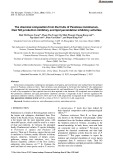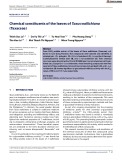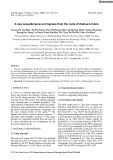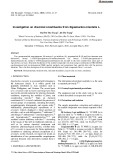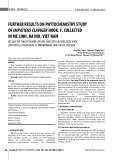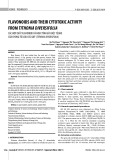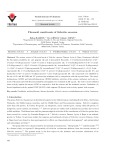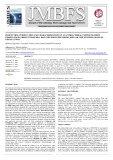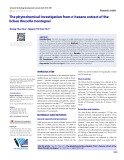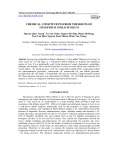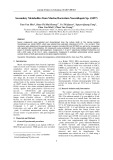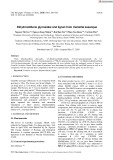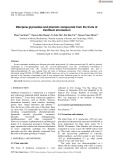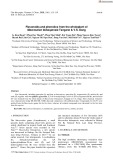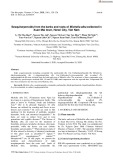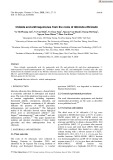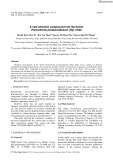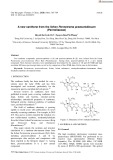
Comparison with NMR data
-
Seven known compounds, including two neolignans, four lignans, and one flavane were isolated from the methanol extract of Pandanus tonkinenis fruits. Their structures were determined to be ficusal, vladinol F, medioresinol, syringaresinol, lariciresinol, secoisolariciresinol, and luteoliflavan by analysis of MS and NMR data as well as by comparison of their spectral data with those reported in the literature.
 7p
7p  dianmotminh02
dianmotminh02
 03-05-2024
03-05-2024
 3
3
 1
1
 Download
Download
-
From CHCl3-soluble extract of the leaves of Taxus wallichiana (Taxaceae), collected in Lam Dong Province, five compounds were isolated and identified as sciadopitysin, ginkgetin, (S)-(+)-rhododenol, (+)-erythro-N-benzoyl3-phenylisoserine methyl ester, and (−)-α-conidendrin (5). Their chemical structures were determined by 1D and 2D NMR spectra and comparison with published data. Except for (−)-α-conidendrin, these remaining compounds were first reported of Taxus wallichiana.
 6p
6p  dianmotminh02
dianmotminh02
 03-05-2024
03-05-2024
 5
5
 3
3
 Download
Download
-
One new sesquiterpene, (4S,7R,10S)-2-oxo-4,10,11-trihydroxyguaia-1(5)-ene, and five lignans, kadsuralignan J, isovaleroylbinankadsurin A, schizandrin O, futokakadsurin C and arisantetralone were isolated from the roots of Kadsura induta. Their chemical structures were revealed by MS, 1D and 2D NMR spectra in comparison with the reported data. The absolute configuration of compound 1 was determined by calculation of its theoretical ECD spectra and compared with the experimental results.
 9p
9p  dianmotminh02
dianmotminh02
 03-05-2024
03-05-2024
 4
4
 2
2
 Download
Download
-
wo germacranolide sesquiterpenes, 9β-acetoxy-3-epi-nobilium, zoapatanolide B and four benzoate ester derivatives, benzyl 2-O-β-D-glucopyranosyl-6-methoxybenzoate, benzyl 2-O-β-D-glucopyranosyl-6- hydroxybenzoate, methyl 2-O-β-D-glucopyranosylbenzoate, ficuside G were isolated from aerial part of Sigesbeckia orientalis. Structural elucidation of the isolated compounds was done using a combination of HR-ESI-MS, one-dimensional and two-dimensional NMR spectral methods, and comparison their spectral data with the previous literature.
 7p
7p  dianmotminh02
dianmotminh02
 03-05-2024
03-05-2024
 4
4
 2
2
 Download
Download
-
Three compounds were isolated from the butanol extract of Impatiens claviger’s leaves and twigs collected in Me Linh, Ha Noi. Their structures were elucidated by the mass, NMR spectroscopy and comparison with published data as two phenolic glucosides and one triterpene glycoside. One of them has been found for the first time in Impatiens genus.
 4p
4p  vifalcon
vifalcon
 18-05-2023
18-05-2023
 2
2
 2
2
 Download
Download
-
Three flavones (1-3) were isolated from the aerial part of Tithonia diversifolia (Hemsl.) A. Gray growing in Hoa Binh province, Vietnam. Their structures were identified as hispidulin (1), nepetin (2) and luteotin (3) by analysis of these spectroscopic MS, NMR data and comparison with reported data.
 4p
4p  viericschmid
viericschmid
 12-01-2022
12-01-2022
 16
16
 0
0
 Download
Download
-
The compounds were identified by the use of 1D- and 2D-NMR and UV spectroscopic techniques and by comparisons with the reported data. The acetylcholinesterase (AChE) and butyrylcholinesterase (BChE) inhibitory activities of the acetone, methanol, and water extracts of the plant and of the flavones penduletin and apigenin were evaluated at 200 µg/mL. The water extract exhibited better activity against the enzyme AChE as compared to both the acetone and the methanol extracts. Penduletin (1) showed significant activity against BChE (66.
 9p
9p  langthannam
langthannam
 29-12-2021
29-12-2021
 10
10
 0
0
 Download
Download
-
Studies on the effect of different nutritional compounds on antibiotic activity revealed that the highest antibacterial activity was obtained when 1% starch (w/v) was used as the sole carbon source along with mineral trace elements. Extraction and purification of TBG19NRA1 culture supernatant led to the isolation of a pure molecule with good antibacterial activity. The compound has been identified as the cyclic polyether lasalocid A on the basis IR, MS and 13C NMR data interpretation and comparison with reference data from literature.
 11p
11p  princessmononoke
princessmononoke
 30-11-2021
30-11-2021
 7
7
 1
1
 Download
Download
-
The crude extract was obtained from the dried lichen powder's extraction at room temperature. The n-hexane, n-hexane-ethyl acetate, and ethyl acetate extracts were obtained by the liquid-liquid partition method. The organic compounds were isolated from n-hexane extract by silica gel and Sephadex LH-20 column chromatography. Their chemical structures were identified by the NMR and HR-ESI-MS data analysis and the comparison of their NMR data with the published data.
 5p
5p  spiritedaway36
spiritedaway36
 28-11-2021
28-11-2021
 12
12
 1
1
 Download
Download
-
This is the first time that it is from its roots, which were collected at Vi Xuyen district - Ha Giang province, were five compounds isolated. These compounds include two phenylethanoid glycosides, verbascoside (1), arenarioside (2); one iridoid glucoside, myxopyroside (3); one indole, 3-formylindole (4), and one furfural, 5-hydroxymethyl furfural (5). Their chemical structures were determined by ESI-MS, 1D-, 2D-NMR spectroscopic data analysis as well as in comparison with those reported in the literatures.
 9p
9p  spiritedaway36
spiritedaway36
 25-11-2021
25-11-2021
 4
4
 1
1
 Download
Download
-
Seven compounds were isolated and characterized from the culture broth of the marine bacteria Nocardiopsis sp. (strain G057), which was isolated from sediment collecting at Cô Tô – Quảng Ninh. Their structures were determined by spectroscopic analysis including MS and 2D NMR, as well as by comparison with reported data in the literature. All compounds were evaluated for their antimicrobial activity against a panel of clinically significant microorganisms. Compounds 1, 2 and 7 selectively inhibited Escherichia coli with a MIC value of 32, 64, 8 μg/mL, respectively.
 5p
5p  cothumenhmong11
cothumenhmong11
 10-05-2021
10-05-2021
 8
8
 1
1
 Download
Download
-
One lignan (7′S,8′R,8S)-4,4′-dihydroxy-3,3′,5,5′-tetramethoxy-7′,9-epoxylignan-9′-ol-7-one (1) together with four neolignans (7α,8α)-dihydrodehydrodiconiferyl alcohol 9-O-β-D-glucopyranoside (2), (7α,8α)-dihydrodehydrodiconiferyl alcohol 9′-O-β-D-glucopyranoside (3), icariside E3 (4), and icariside E5 (5) were isolated from Pouzolzia sanguinea. Their chemical structures were elucidated by ESI-MS, NMR spectra, as well as in comparison with the data reported in literature.
 7p
7p  cothumenhmong11
cothumenhmong11
 06-05-2021
06-05-2021
 10
10
 2
2
 Download
Download
-
Three dihydrostilbene glycosides, 3,5-dihydroxydihydrostilbene 4′-O-β-D-glucopyranoside (1), 3,5- dimethoxydihydrostilbene 4′-O-α-L-rhamnopyranosyl-(1→6)-β-D-glucopyranoside (2), 5,4′-dihydroxydihydrostilbene 3-O-β-D-glucopyranoside (3), and one lignan, nudiposide (4) were isolated from the methanol extract of leaves of Camellia sasanqua Thunb. Their chemical structures were determined by using ESI-MS and NMR spectra as well as in comparison with the reported data. Compounds 3 and 4 were reported from Camellia genus for the first time.
 5p
5p  cothumenhmong11
cothumenhmong11
 06-05-2021
06-05-2021
 15
15
 2
2
 Download
Download
-
Their chemical structures were determined using ESI-MS, 1D NMR, and 2D NMR spectra as well as by comparison of the spectral data with those reported in the literature. Compounds 4 and 5 were reported from Xanthium genus for the first time. To our best knowledge, all these compounds were firstly reported from X. strumarium growing in Vietnam.
 6p
6p  cothumenhmong11
cothumenhmong11
 06-05-2021
06-05-2021
 18
18
 2
2
 Download
Download
-
Their chemical structures were characterized using HR-ESI-MS, NMR data and comparison with published data. Compounds (3, 4 & 7) were notified from the Macrosolen genus for the first time, whereas, all isolated compounds were informed for the first time from this species.
 5p
5p  nguaconbaynhay11
nguaconbaynhay11
 16-04-2021
16-04-2021
 14
14
 2
2
 Download
Download
-
Eight sesquiterpenoids including costunolide (1), parthenolide (2), 11α,13-dihydroparthenolide (3), 9β-hydroxydihydroparthenolide (4), (-)-bisparthenolidine (5), 11α,13-dihydro-β-cyclocostunolide (6), α-cadinol (7), magnograndiolide (8) were isolated from the barks and roots of Michelia alba. The structures of these compounds were elucidated by spectroscopic methods (MS, 1D and 2D NMR) and comparison with the reported data. Compounds 5-8 have been isolated for the first time from Michelia alba.
 7p
7p  nguaconbaynhay11
nguaconbaynhay11
 16-04-2021
16-04-2021
 14
14
 2
2
 Download
Download
-
Three iridoids, asperulosidic acid (1), geniposidic acid (2), and galioside (3) and three anthraquinones, 2- hydroxymethyl-3-hydroxyanthraquinone (4), rubiadin-1-methyl ether (5), and anthragallol-2-methyl ether (6) were isolated from the methanol extract of the Morinda officinalis leaves. Their chemical structures were elucidated by ESIMS, 1D- and 2D-NMR spectra and comparison with the data reported in the literature. Galioside (3) was reported from Morinda genus for the first time.
 5p
5p  nguaconbaynhay11
nguaconbaynhay11
 16-04-2021
16-04-2021
 19
19
 1
1
 Download
Download
-
Chemical investigation of the lichen Parmotrema praesorediosum (Nyl.) Hale led to isolate six phenolic compounds including praesorediosic (1), orcinol (2), orselinic acid (3), lecanorin (4), isolecanoric acid (5) and virensic acid (6). Among them, compound 1 appeared to be found for the first time in the nature. The structure of these compounds was elucidated by spectroscopic analyses of HRESIMS and NMR as well as the comparison of their NMR data with those in the literature.
 5p
5p  nguaconbaynhay11
nguaconbaynhay11
 16-04-2021
16-04-2021
 20
20
 1
1
 Download
Download
-
Chemical investigation of the marine sponge-derived fungal strain Aspergillus sp. IMBC-FP2.05 resulted in isolation of five compounds, including JBIR-74 (1), homogentisic acid (2), methyl (2,5-dihydroxyphenyl)acetate (3), 3- chloro-2,5-dihydroxybenzyl alcohol (4), and p-hydroxybenzaldehyde (5). Their chemical structures were identified by comprehensive analyses of the 1D and 2D NMR and mass spectra in comparison with the previously reported data. Furthermore, nitric oxide (NO) inhibitory effects of the isolated compounds in LPS-stimulated RAW264.7 cells were also reported.
 5p
5p  nguaconbaynhay11
nguaconbaynhay11
 16-04-2021
16-04-2021
 9
9
 2
2
 Download
Download
-
Two xanthone compounds, praesorexanthone A (1) and praesorexanthone B (2), were isolated from the lichen Parmotrema praesorediosum (Nyl.) Hale (Parmeliaceae). Among them, praesorexanthone B is a new natural compound. Their chemical structures were unambiguously determined by the analysis of 1D and 2D NMR and high resolution ESI mass spectroscopic data, as well as by comparison of their NMR data with the ones in the literature.
 5p
5p  nguaconbaynhay11
nguaconbaynhay11
 16-04-2021
16-04-2021
 8
8
 2
2
 Download
Download
CHỦ ĐỀ BẠN MUỐN TÌM








